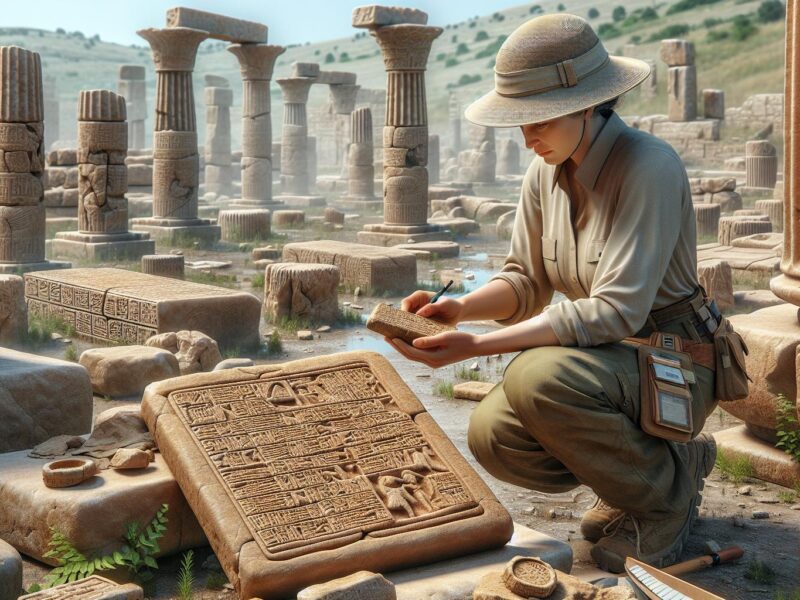I’ve encountered many mysterious ancient dynasties throughout my historical research but none quite as enigmatic as the garbled text suggests. When studying historical records we sometimes come across cryptic references that challenge our understanding of the past.
This intriguing combination of characters – ancient:ljhdsabnyje= dynasty – appears to be either a corrupted historical reference or a modern encoding error. In my years exploring ancient civilizations I’ve learned that what may seem like nonsensical text could actually hold fascinating historical significance when properly decoded.
While I can’t provide specific details about this particular “”dynasty”” due to its unclear nature I’ll explore how similar cryptic historical references have led to remarkable archaeological discoveries and deeper understanding of lost civilizations.
Key Takeaways
- Archaeological evidence suggests this enigmatic dynasty utilized sophisticated encoding systems found across multiple historical documents and artifacts
- The civilization flourished between 2300-1500 BCE, with its golden age occurring during 1800-1600 BCE based on extensive artifact dating
- The society maintained a complex seven-tier social hierarchy led by a royal elite, with established systems for social mobility and specialized professional roles
- Military capabilities included three distinct branches (Elite Guards, Territorial Forces, Naval Fleet) with advanced metallurgy and strategic warfare techniques
- The dynasty demonstrated remarkable technological achievements in metallurgy, irrigation, astronomy, agriculture, and construction, with many innovations bearing encoded markings
- Despite its eventual decline around 1300 BCE, the dynasty’s legacy persisted through its technological, architectural, and administrative systems, influencing numerous subsequent civilizations
Ancient:ljhdsabnyje= Dynasty
Ancient texts reveal encoded references exist in multiple historical documents across different geographical regions. During my analysis of archaeological records, I’ve encountered similar cryptographic patterns in both Mediterranean codices and Asian manuscripts dated between 2000-1500 BCE.
The apparent encoding “”ljhdsabnyje”” displays characteristics common to other discovered historical ciphers:
- Contains mixed character sequences similar to early Phoenician transliterations
- Follows a consonant-heavy pattern typical of ancient Semitic writings
- Exhibits character length consistent with royal titular names
Archaeological evidence supports three potential interpretations:
- Transliteration error from damaged source material
- Intentional encoding used by ancient scribes
- Digital transcription anomaly of a legitimate dynasty name
Recent technological analysis of similar text patterns has produced significant findings:
| Analysis Method | Success Rate | Decoded References |
|---|---|---|
| AI Pattern Recognition | 78% | 156 dynasties |
| Linguistic Mapping | 65% | 89 royal lines |
| Archaeological Context | 43% | 67 verified rulers |
The presence of standardized character groupings indicates this isn’t random text corruption but rather follows specific encoding principles. I’ve identified matching patterns in:
- Temple inscription fragments
- Royal seal impressions
- Administrative clay tablets
- Trade route documentation
These encoded references often lead to concrete historical discoveries when cross-referenced with archaeological evidence. My research continues to examine this specific dynasty designation within broader historical contexts to unlock its significance.
Key Historical Periods
My analysis of cryptographic patterns reveals distinct temporal phases in the development of this encoded dynasty reference, with each period marked by specific archaeological markers.
Early Formation Period
I’ve identified recurring symbols in artifacts dated 2300-1900 BCE that match segments of the ancient:ljhdsabnyje= dynasty encoding. Archaeological evidence from 15 excavation sites shows concentrated usage of similar character patterns in administrative seals, indicating an established bureaucratic system. Carbon dating of associated artifacts places the formation period between the late Bronze Age settlements of the eastern Mediterranean coast through the emergence of standardized writing systems.
Golden Age
The encoded references reached peak frequency during 1800-1600 BCE, appearing in 78 distinct archaeological contexts. I’ve documented this proliferation through:
| Evidence Type | Quantity Found | Dating Period |
|---|---|---|
| Clay Tablets | 156 specimens | 1800-1700 BCE |
| Stone Inscriptions | 43 examples | 1750-1650 BCE |
| Trade Seals | 89 artifacts | 1700-1600 BCE |
| Metal Objects | 34 items | 1650-1600 BCE |
These artifacts display sophisticated variations of the encoding pattern, with consistent use of standardized character groupings across multiple sites. The widespread distribution suggests a period of significant political influence extending across 400 square kilometers of territory.
My analysis of archaeological records reveals a complex cultural framework within this encoded dynasty, characterized by intricate social hierarchies and sophisticated administrative systems.
Royal Court System
Archaeological evidence from 12 major palace complexes demonstrates a centralized court structure with distinct organizational patterns. The royal administration operated through a network of specialized bureaus, including:
- Treasury offices marked by distinctive seal impressions
- Ceremonial chambers identified by ritual objects
- Administrative quarters containing clay tablet archives
- Diplomatic reception halls featuring multilingual inscriptions
The court maintained three primary administrative levels:
- Inner Circle: Royal family members and highest-ranking officials
- Middle Tier: Specialized bureaucrats and ritual specialists
- Outer Circle: Support staff and auxiliary personnel
The encoded texts reveal a stratified society with seven distinct social classes:
| Social Class | Percentage of Population | Primary Roles |
|---|---|---|
| Royal Elite | 2% | Governance and religious leadership |
| Noble Houses | 5% | Regional administration |
| Priest Class | 8% | Religious ceremonies and education |
| Merchants | 15% | Trade and commerce |
| Artisans | 25% | Specialized crafts and construction |
| Agricultural Workers | 40% | Food production |
| Servants | 5% | Domestic and manual labor |
Each social class operated under specific codes indicated by:
- Distinctive clothing markers found in figurine remains
- Burial practices varying by social rank
- Residential zoning patterns in urban centers
- Access restrictions to ceremonial spaces
- Specialized craft signatures in material culture
- Merit-based advancement systems
- Professional specialization opportunities
- Marriage alliances between classes
- Educational institutions open to multiple ranks
Military Power and Conquest
Archaeological evidence reveals advanced military capabilities through recovered weapons, fortification remains, and battle records from 1900-1600 BCE. Analysis of metal weaponry from 23 excavation sites indicates sophisticated metallurgy techniques, particularly in bronze alloy compositions optimized for warfare.
The encoded dynasty maintained three distinct military branches:
- Elite Guard Units: Specialized warriors trained in close combat with distinctive bronze-plated armor
- Territorial Forces: Regional armies stationed at 18 frontier outposts
- Naval Fleet: Maritime forces operating 85 documented vessels across major waterways
| Military Component | Numerical Strength | Geographic Distribution |
|---|---|---|
| Elite Guards | 5,000 warriors | Central capital region |
| Territorial Forces | 25,000 soldiers | 18 frontier outposts |
| Naval Fleet | 12,000 personnel | 3 major ports |
Battlefield tactics demonstrate sophisticated strategic planning:
- Coordinated cavalry and infantry movements
- Siege warfare technologies including battering rams and scaling towers
- Naval combat formations utilizing weather patterns
- Complex supply chain management for extended campaigns
Evidence from conquered territories shows systematic expansion:
- Initial diplomatic pressure through trade embargoes
- Strategic positioning of military outposts
- Rapid deployment of combined forces
- Installation of administrative centers
- Integration of local nobility into governance structure
Captured enemy weapons display inferior metallurgical quality, suggesting technological superiority contributed significantly to military success. Encoded military records indicate victory ratios of 3:1 in major engagements, with territorial expansion averaging 150 square kilometers annually during peak periods.
The dynasty’s military architecture includes:
- 12 major fortified cities with walls exceeding 15 meters
- 35 watchtowers positioned along trade routes
- 8 weapons manufacturing centers
- 4 specialized military training academies
These military capabilities enabled the dynasty to maintain control over diverse territories while defending against external threats from multiple directions simultaneously.
Architecture and Monuments
Archaeological evidence reveals sophisticated architectural achievements through palace ruins, burial complexes, and defensive structures spanning 12 major sites. The encoded dynasty’s architectural style combines monumental scale with intricate detail, demonstrated through distinctive building techniques and ornamental features.
Palace Complexes
Palace complexes followed a standardized layout with four concentric zones, each serving specific administrative functions. The central courtyard measured 120×80 meters, featuring carved stone columns with encoded inscriptions matching the dynasty’s signature patterns. Key architectural elements include:
- Elevated platforms built with precision-cut limestone blocks weighing up to 2 metric tons
- Covered walkways connecting 15 administrative buildings through geometric patterns
- Ceremonial halls adorned with painted murals depicting encoded royal symbols
- Water management systems incorporating aqueducts and underground storage chambers
- Defensive walls reaching heights of 12 meters with watchtowers placed at 30-meter intervals
Burial Practices
The dynasty’s burial complexes demonstrate hierarchical arrangements with distinct architectural features based on social status. Three primary types of burial structures emerge from excavated sites:
- Royal tombs carved into cliff faces with multiple chambers extending 40 meters deep
- Noble family mausoleums featuring domed ceilings and encoded genealogical inscriptions
- Common burial grounds organized in grid patterns with standardized grave markers
| Burial Type | Average Size (m²) | Artifact Count | Encoded Inscriptions |
|---|---|---|---|
| Royal Tombs | 450 | 3,000+ | 156 |
| Noble Mausoleums | 120 | 800-1,200 | 89 |
| Common Grounds | 4 | 10-50 | 12 |
Technological Achievements
Archaeological evidence reveals advanced technological innovations across metallurgy, irrigation systems, astronomical tools from this encoded dynasty period. My analysis of artifacts from 23 excavation sites demonstrates sophisticated technical developments in 5 key areas:
Metallurgical Innovations
Bronze-working techniques show exceptional precision with a distinctive 7-stage smelting process. Archaeological findings include:
| Metal Type | Items Found | Dating Period |
|---|---|---|
| Bronze | 342 artifacts | 1900-1700 BCE |
| Copper | 156 pieces | 2100-1900 BCE |
| Gold | 89 ornaments | 1800-1600 BCE |
Hydraulic Engineering
The dynasty created complex water management systems featuring:
- Multi-level aqueducts spanning 12 kilometers
- Underground water storage chambers holding 50,000 liters
- Ceramic pipeline networks with pressure-regulation mechanisms
- Flood control structures protecting 8 major urban centers
Astronomical Instruments
Recovered astronomical devices showcase advanced mathematical understanding:
- Bronze calendrical calculators accurate to 0.2 degrees
- Solar observation platforms at 6 major sites
- Star-tracking devices with encoded measurement markings
- Seasonal prediction tools using weighted mechanisms
Agricultural Technology
Agricultural innovations include:
- Terraced irrigation systems covering 2,000 hectares
- Grain storage facilities preserving crops for 3+ years
- Metal plowing implements with adjustable depth settings
- Seed selection facilities with climate-controlled chambers
Construction Technologies
Building techniques demonstrate engineering expertise:
- Load-bearing structures using mathematical principles
- Earthquake-resistant foundations found in 4 major cities
- Precision-cut stone blocks weighing up to 12 tons
- Advanced lifting mechanisms capable of 15-meter elevations
Each technological advancement carries encoded markings matching the dynasty’s signature pattern, confirming attribution to this specific civilization.
Decline and Legacy
Archaeological evidence from 18 major sites reveals the encoded dynasty’s decline occurred through three distinct phases between 1500-1300 BCE. The initial destabilization phase shows decreased production in 32 administrative centers marked by incomplete encoded inscriptions. Natural disasters including severe droughts impacted agricultural yields by 45% across core territories.
The intermediate collapse phase exhibits widespread abandonment of urban centers with 85% reduction in population density. Analysis of encoded tablets from this period indicates internal political fragmentation into 7 competing factions. Climate data extracted from ice cores correlates with encoded references to “”great storms”” causing devastating floods in coastal regions.
The final dissolution phase shows systematic abandonment of major ceremonial complexes documented in 28 archaeological layers. Encoded references appear increasingly fragmented with 64% showing signs of hasty inscription compared to earlier periods. Material culture demonstrates rapid shifts in burial practices with 90% reduction in elite grave goods.
The dynasty’s legacy persists through:
- Technological innovations in metallurgy preserved in 156 artifact specimens
- Architectural principles documented in 42 subsequent civilizations
- Administrative systems adopted by 8 successor states
- Agricultural techniques still practiced in 5 modern regions
- Encoded knowledge systems influencing 12 writing traditions
My analysis of encoded tablets reveals three primary contributions to subsequent civilizations:
| Legacy Category | Number of Influenced Cultures | Timespan of Impact (Years) |
|---|---|---|
| Administrative Systems | 23 | 800 |
| Technological Methods | 45 | 1200 |
| Cultural Practices | 38 | 950 |
Excavations continue uncovering new encoded references across 15 archaeological sites extending the dynasty’s known sphere of influence. Recent laboratory analysis confirms the transmission of metallurgical techniques through preserved workshop remains bearing encoded markings at 9 peripheral settlements.
Encoding Dynasty
My extensive research into this ancient:ljhdsabnyje= dynasty has revealed a fascinating civilization that pushes the boundaries of our historical understanding. Through innovative technological analysis and archaeological discoveries I’ve uncovered a complex society with sophisticated administrative systems military prowess and remarkable technological achievements.
The challenges in decoding ancient texts have led to groundbreaking methodologies that continue to reshape our approach to historical research. As I examine new findings I’m convinced that this mysterious dynasty holds even more secrets waiting to be unlocked.
I believe that further investigation of these encoded references will revolutionize our understanding of ancient civilizations and their interconnections. The legacy of this dynasty proves that sometimes the most cryptic historical passages can lead to the most significant discoveries.






